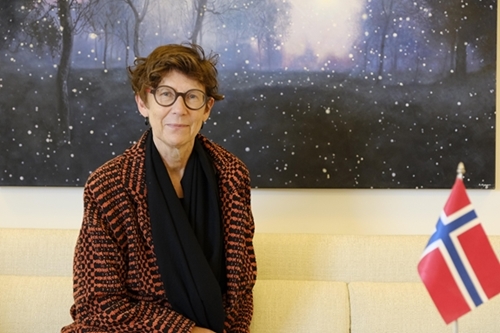Reporter: Norway has made considerable contributions to the detection and clearance of UXO in various countries in the world, including Vietnam. Could you please elaborate on those contributions, Ms. Ambassador?
Ambassador Grete Løchen: Aid for UXO consequence relief activities is part of our humanitarian policy and Norway’s responsibility when joining international conventions, such as the Anti-Personnel Mine Ban Convention (APMBC) adopted in 1997 in Oslo and the Convention on Cluster Munitions that Norway is the first country to sign on in 2008. 2019 is the year that Norway chairs the APMBC. Protecting people from UXO risks is also a central point in the National Humanitarian Strategy that Norway adopted in 2018.
    |
 |
|
Norweigian Ambassador to Vietnam Grete Løchen |
Aid for UXO consequence mitigation activities is not simply limited to UXO clearance and protection of people from UXO. More significantly, it also helps realize sustainable development goals. After the clearance of UXO, people can live and cultivate on the decontaminated land, helping reduce poverty and maintain food security. Children can go to school; water and electricity supply stations and electricity grids can be restored, ensuring clean water and electricity for people…
Norway’s aid to those activities is in the form of financial and human resources and equipment to map out localities in risk of UXO. UXO clearance is then conducted while education and dissemination of information about UXO risks will be provided, helping local people lead a more peaceful life. Together with the US, Germany, the EU and Japan, Norway is one of the biggest donors for mine and cluster munitions clearance in the world. In 2017, Norway contributed about USD 40 million to those activities and the figure will be maintained in 2019. Aid from Norway is mostly allocated through humanitarian organizations. Apart from that, it is also allocated directly to national UXO clearance organizations.
Reporter: War was long over in Vietnam; however, UXO consequences still linger on. How do you assess the efforts of the Vietnamese Government in cleaning war-left UXO-contaminated land?
Ambassador Grete Løchen: It hurts when hearing the statistics on the real situation of UXO-contamination in Vietnam. Almost all of the 63 provinces and cities nationwide have areas contaminated with UXO. The total area of 6.1 UXO-contaminated hectares accounts for 18.7% of the whole area of the country. Information about UXO accidents has still been reported, with victims including women and children.
    |
 |
|
War-left UXO found in a citizen’s house in Gio Linh district of Quang Tri province. Photo: NPA |
I’m happy to learn that the Government of Vietnam sees the mitigation of UXO consequences an immediate task and has made efforts in improving the institutional and legal framework for UXO mitigation activities to protect people and support victims to reintegrate into the community while providing livelihoods for them and helping them settle down their lives.
Vietnam has developed its National Action Program on the Settlement of Post-War Unexploded Ordnance for the 2010-2025 period. The first phase of the examination of the war-left UXO remnants in Vietnam has been completed. In April 2018, the Vietnam Mine Action Center published a report giving an overview of the real situation of UXO remnants nationwide, serving as the foundation for defining areas in need of prioritized support.
One of the encouraging achievements of Vietnam is that the country has been participating in international cooperation activities and made increasingly effective use of aid for UXO activities. However, I see that there is still much to be done.
Reporter: Could you please tell us more about the support of Norway’s organizations for Vietnam in revitalizing “dead land”?
Ambassador Grete Løchen: We are proud that the Norwegian People’s Aid (NPA) has actively operated in Vietnam since 2008 and supported Vietnam in its efforts to settle bomb and mine consequences. The NPA is one of the three biggest humanitarian UXO-clearance organizations in the world.
The NPA’s activities in Vietnam aim at reducing the risks of war-left cluster munitions and other UXO, ensuring a peaceful environment for people and facilitating development. In Vietnam, the NPA directly engages in studying and clearing bombs and mines while helping build capacity for state agencies at the central and local levels.
The most noticeable contribution of the NPA to Vietnam in this field is the method of surveying cluster munitions remnants developed and implemented by this organization itself. This is the evidence-based survey method to define cluster munitions-contaminated areas and the volume of contamination in Vietnam. UXO clearance to reclaim land for people to live a peaceful life is the top priority of the NPA.
76,588 cluster munitions and other UXO found and safely detonated, nearly 3 million square meters of land reclaimed for development and construction of public works and football fields for students, 28 field survey groups professionally trained and equipped in line with international mine action standards, and more... are the impressive achievements in operation of the NPA in Vietnam.
What the NPA and other UXO clearance organizations are doing is believe to play an important role.
Reporter: Thank you very much for your time!
Interviewer: Phuong Linh
Translated by Huu Duong